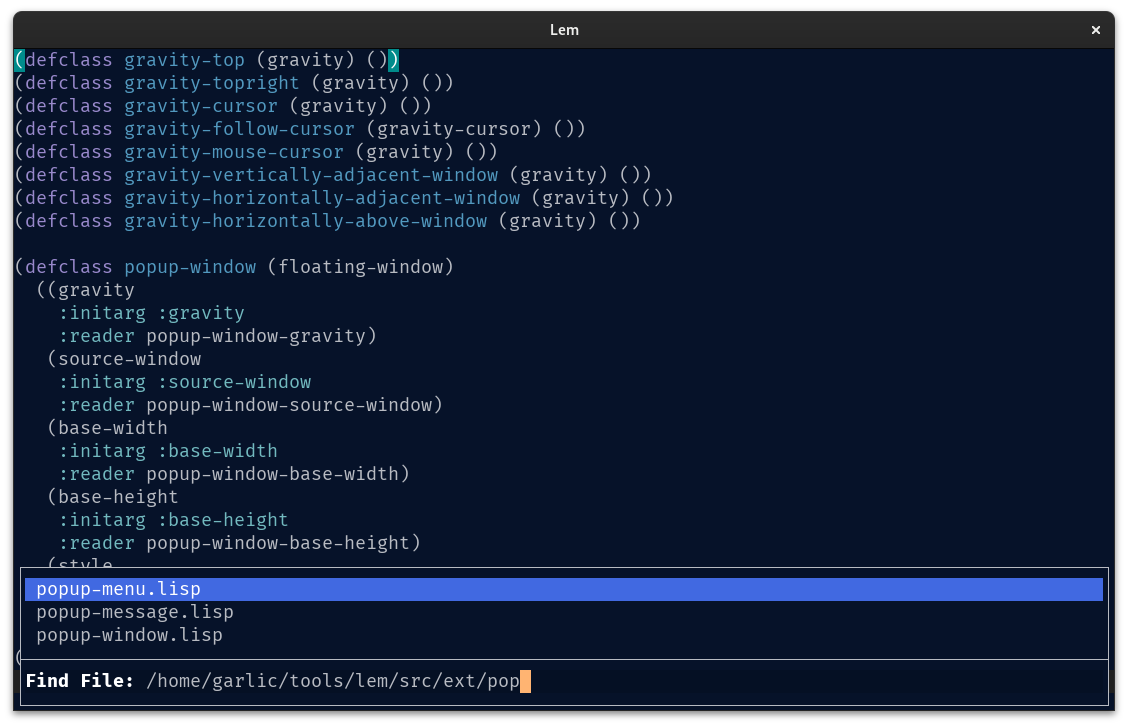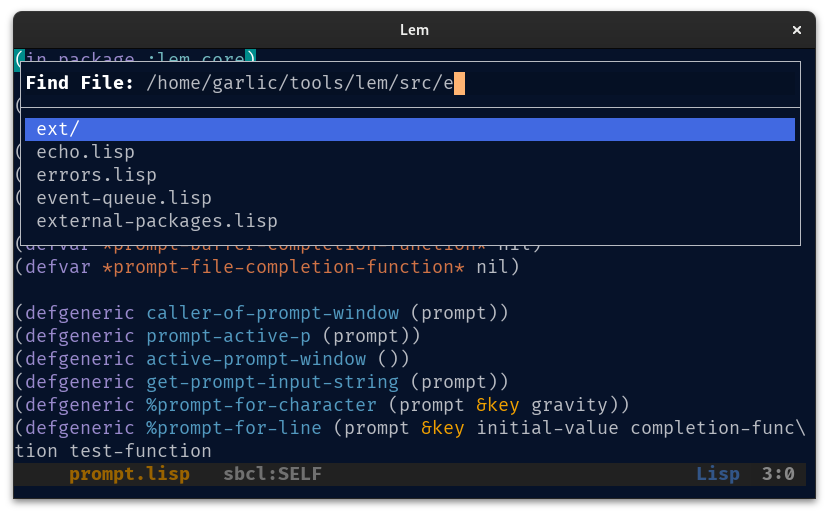Configuration
Lem loads ~/.lem/init.lisp when starting up.
You probably want to start it with
(in-package :lem-user)
Otherwise, be sure to refer to Lem functions with the lem: prefix.
The completion pop-up, like the one we get with M-x, wants us to
press TAB before we get the completion candidates. If you want to open
it right away, add this to your init file:
(add-hook *prompt-after-activate-hook*
(lambda ()
(call-command 'lem/prompt-window::prompt-completion nil)))
(add-hook *prompt-deactivate-hook*
(lambda ()
(lem/completion-mode:completion-end)))
You can start typing and the list will narrow down.
Lem’s completion pop-up is by default centered on the middle of the screen.
Since May of 2024, it is possible to choose its position: à la Emacs at the bottom? À la VSCode at the top?
If you want the completion pop-up at the bottom like this:

Add this to your init file:
(setf lem-core::*default-prompt-gravity* :bottom-display)
(setf lem/prompt-window::*prompt-completion-window-gravity* :horizontally-above-window)
(setf lem/prompt-window::*fill-width* t)
If you want it at the top like this:

Add this to your init file:
(setf lem-core::*default-prompt-gravity* :top-display)
(setf lem/prompt-window::*fill-width* t)
There is more. You can allow the order of completions to be reversed: this is helpful when the prompt is at the bottom of the screen, so that the firts completion candidate is just above the prompt, so you don’t have to move your eyes. Use this so that completions are reversed in regular prompts, but normal in code completion::
(add-hook *prompt-after-activate-hook*
(lambda ()
(setf lem/completion-mode::*completion-reverse* t)
(call-command 'lem/prompt-window::prompt-completion nil)))
(add-hook *prompt-deactivate-hook*
(lambda ()
(setf lem/completion-mode::*completion-reverse* nil)
(lem/completion-mode:completion-end)))
We will learn how to bind your own keys to commands. Afterwards we’ll learn how to write your own interactive commands.
Use the define-key function to associate a keybinding to a command:
(lem:define-key lem:*global-keymap*
"C-x F" 'lem-core/commands/file:find-file-recursively)
Its first argument is a keymap. Essentially, there is a keymap for
global keybindings, for each programming language mode (such as
lem-python-mode::*python-mode-keymap*, you can find it in Lem with
the autocompletion), and for every other tool: there is a keymap for
grep mode, for the directory mode, for the different vi mode states,
etc.
You can also use lem:define-keys to define more than one key at once:
;; C-h is initially bound to delete-previous-char
(define-keys *global-keymap*
("C-h b" 'describe-bindings)
("C-h k" 'describe-key)
("C-h a" 'lem-lisp-mode:lisp-apropos)
("C-h c" 'apropos-command)
("C-h p" 'lem-lisp-mode:lisp-apropos-package)
("C-h f" 'lem-lisp-mode:lisp-describe-symbol))
But wait, there is more.
Did you notice that all the above commands have
the C-h prefix? We can refactor this.
First, we define a keymap object. Let’s take another example, the frame-multiplexer (aka tabs):
(defvar *keymap*
(make-keymap :name '*frame-multiplexer-keymap*)
"Keymap for commands related to the frame-multiplexer.")
Now we can use (define-key *keymap* key command) (singular), like this:
(define-key *keymap* "c" 'frame-multiplexer-create-with-new-buffer-list)
(define-key *keymap* "d" 'frame-multiplexer-delete)
(define-key *keymap* "p" 'frame-multiplexer-prev)
(define-key *keymap* "n" 'frame-multiplexer-next)
(define-key *keymap* "r" 'frame-mulitplexer-rename)
And now we can define the prefix key for our keymap and all its sub-keys commands:
(define-key *global-keymap* "C-z" *keymap*)
As a result, we defined C-z c for 'frame-mulitplexer-create-with-new-buffer-list.
Did you define keys? It’s also possible to undefine them.
NOTE: this function was added the 1st of January, 2025.
Use undefine-key and undefine-keys.
Example:
(undefine-key *paredit-mode-keymap* "C-k")
(undefine-keys *paredit-mode-keymap* ("C-k")
("C-L"))
Use define-command:
(in-package :lem)
(define-command open-init-file () ()
;; @sasanidas
(lem:find-file
(merge-pathnames "init.lisp" (lem-home))))
or copy-paste this with M-:
(lem:define-command open-init-file () ()
(lem:find-file
(merge-pathnames "init.lisp" (lem:lem-home))))
You can now call it with M-x open-init-file.
How can we give an argument to a command, how can we run it on a region?
The define-command examples above have two empty () (). This is
the place for parameters names and special argument descriptors.
We can tell it to accept a prefix argument (a number), we can make the command ask for user input (a string, an integer, a buffer, a file) and work on region delimiters.
We tell the following command that it accepts a prefix
argument. We use :universal and n is the argument name to use in the
command body. n defaults to 1.
(define-command hellos (n) (:universal)
(dotimes (i n)
(insert-string (current-point) "hello ")))
Call this command M-x hellos and it writes 1 “hello”.
Call it with C-u 3 M-x hellos and it writes “hello” 3 times.
We can also use (&optional n) (:universal-nil) or (&optional (n 3)) (:universal-nil) to
change the default value.
:universal-nil is similar to :universal but doesn’t default to 1.
Use :number. This prompts the user for a number.
Use :string for the arg-descriptor, and (:string "My prompt: ") to give a custom prompt.
This is how a directory-mode is done:
(define-command simple-message (s) ((:string "Enter a string: "))
(message s))
Run it with M-x simple-message.
Use :buffer. It defaults to the current buffer’s name.
There is also :other-buffer that defaults to the other buffer’s name.
Use :file to prompt for a file. It defaults to the current buffer’s directory.
There is also :new-file that defaults to the buffer’s directory and must not be existing.
Next, how can we run a command on a region? A region is defined with a start and end point. We have to tell the command it operates on a region, that way it gives us the two points.
We do so by declaring two start and end arguments, and a special
argument descriptor: :region. Here’s how it is done for the python-eval-region command:
(define-command python-eval-region (start end) (:region)
(unless (alive-process-p)
(editor-error "Python process doesn't exist."))
(lem-process:process-send-input *process* (points-to-string start end)))
We can have multiple arguments, for example:
(define-command multiple-args (regex &optional arg) ((:string "Enter a regex:") :universal-nil)
...)
Lem uses external code formatters that can be run automatically when you save a file.
Currently formatters available by default are:
gofmtfor go-modeclang-formatfor c-modeprettierfor js-mode and json-mode- and it works for lisp code of course.
Additionally, rust-mode uses rustfmt.
To use formatting, you can either manually invoke
M-x format-current-buffer, or enable auto-formatting like this:
(setf lem:*auto-format* t)
Formatters can be defined for major modes, they are implemented as a function that accepts a buffer as an argument. Some are built-in, but you can make your own in two ways:
register-formatter
You can register a formatter for an existing major mode like this:
(lem:register-formatter my-mode #'my-formatter)
define-major-mode
If you are creating your own major mode, you can add a formatter in the mode definition:
(define-major-mode my-mode ()
(:name "My mode"
:keymap *my-mode-keymap*
:formatter #'my-formatter)
)
Hooks allow you to run abritrary code before (or after) a command is called or a given mode is entered (or exited).
Some examples:
after-save-hookkill-buffer-hook*find-file-hook**exit-editor-hook**after-init-hook*- self-insert-hook: run code before or after a character is inserted in the buffer.
- and more: checkout each mode (programming modes, vi mode…) inside Lem with the completion.
The hooks mechanism is defined in src/common/hooks.lisp. It is made of the available functions and macros:
add-hook place callback: add a hook- example:
(add-hook *after-init-hook* #'display-welcome)
- example:
remove-hook place callback: remove a hookrun-hooks list: run all hooks.
Each mode defines a hook variable name. For example:
(define-major-mode c-mode language-mode
(:name "C"
:keymap *c-mode-keymap*
:syntax-table *c-syntax-table*
:mode-hook *c-mode-hook* ;; <---------- defines our hook name
:formatter #'lem-c-mode/format:clang-format)
(setf (variable-value 'enable-syntax-highlight) t)
;; more settings here…
)
(add-hook *c-mode-hook* 'guess-offset) ;; <------ adds a hook
Start Lem in vi-mode:
;; Start in vi-mode
(lem-vi-mode:vi-mode)
We can use a hook to be in vi insert mode when we start the Lisp REPL:
;; Start the Lisp REPL in vi insert mode.
(add-hook lem-lisp-mode:*lisp-repl-mode-hook* 'lem-vi-mode/commands:vi-insert)
The site init configuration allows the user to arrange different libraries/files, the main two important directories to organize the files are:
*inits-directory-name*("~/.lem/lisp"):This directory is intended to have libraries (asdf packages) that are going to be loaded before our configuration files.
"~/.lem/inits":Here is the place we can put our configuration files (which are .lisp files not asdf systems).
It’s usually recommended to make sure that the files are specify in the .asd file that is created at the root of
the (lem-home) directory, usually "~/.lem", the file is lem-site-init.asd, an example maybe:
;; don't edit !!! (you can ignore this warning)
(asdf/parse-defsystem:defsystem "lem-site-init"
:depends-on
(:system-on-lisp-directory)
:components
((:file "inits/my-file-one") (:file "inits/my-file-two")))
Then, in the main init file "init.lisp", you can load the systems + files with the function:
(lem-core:load-site-init)
For inspiration, see those configuration files:
- @fukamachi
- @sasanidas
- @vindarel
- @Gavinok
- @garlic0x1
- @sakurawald Heavily rely on the
vi-mode. - https://gist.github.com/jason-chandler/6332e3fd753fa87e3b1cd13582df5862 getting cxxxr/valtan to work along with paredit and the monokai theme